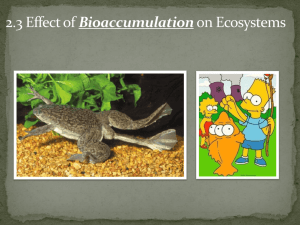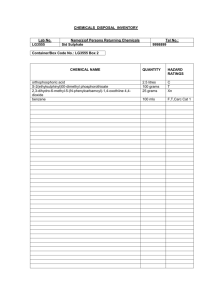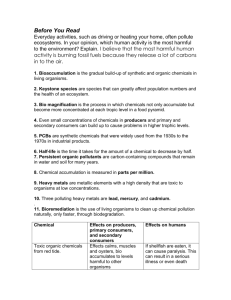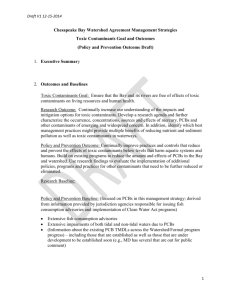Toxic chemicals are released into our ecosystem from a variety of
advertisement
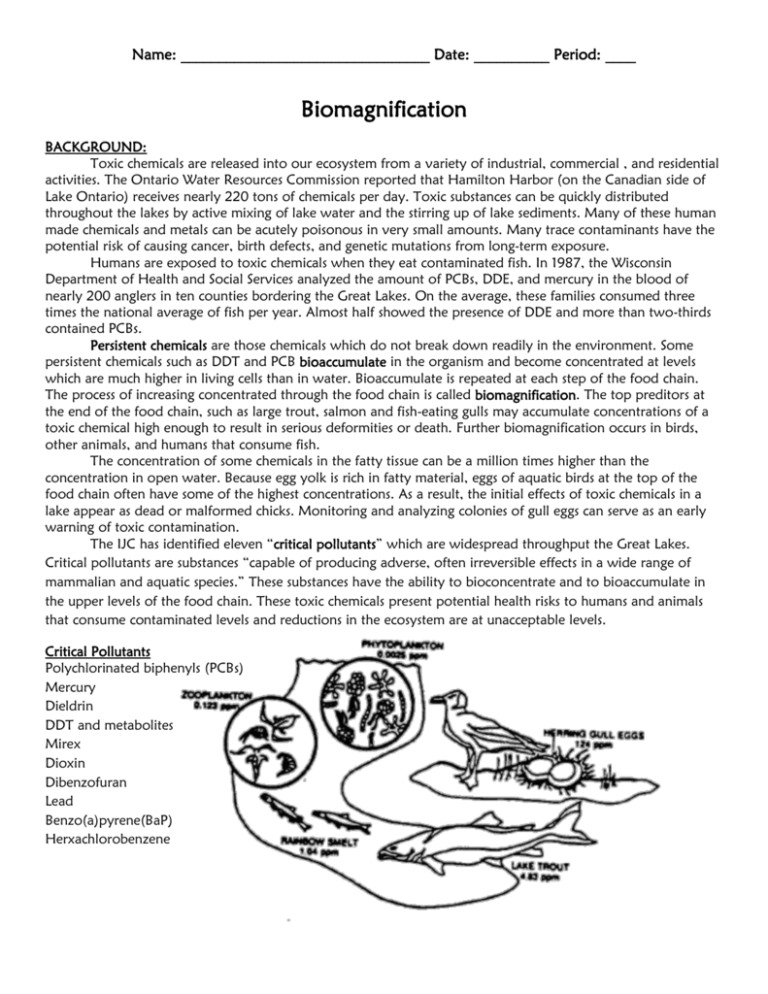
Name: _________________________________ Date: __________ Period: ____ Biomagnification BACKGROUND: Toxic chemicals are released into our ecosystem from a variety of industrial, commercial , and residential activities. The Ontario Water Resources Commission reported that Hamilton Harbor (on the Canadian side of Lake Ontario) receives nearly 220 tons of chemicals per day. Toxic substances can be quickly distributed throughout the lakes by active mixing of lake water and the stirring up of lake sediments. Many of these human made chemicals and metals can be acutely poisonous in very small amounts. Many trace contaminants have the potential risk of causing cancer, birth defects, and genetic mutations from long-term exposure. Humans are exposed to toxic chemicals when they eat contaminated fish. In 1987, the Wisconsin Department of Health and Social Services analyzed the amount of PCBs, DDE, and mercury in the blood of nearly 200 anglers in ten counties bordering the Great Lakes. On the average, these families consumed three times the national average of fish per year. Almost half showed the presence of DDE and more than two-thirds contained PCBs. Persistent chemicals are those chemicals which do not break down readily in the environment. Some persistent chemicals such as DDT and PCB bioaccumulate in the organism and become concentrated at levels which are much higher in living cells than in water. Bioaccumulate is repeated at each step of the food chain. The process of increasing concentrated through the food chain is called biomagnification. The top preditors at the end of the food chain, such as large trout, salmon and fish-eating gulls may accumulate concentrations of a toxic chemical high enough to result in serious deformities or death. Further biomagnification occurs in birds, other animals, and humans that consume fish. The concentration of some chemicals in the fatty tissue can be a million times higher than the concentration in open water. Because egg yolk is rich in fatty material, eggs of aquatic birds at the top of the food chain often have some of the highest concentrations. As a result, the initial effects of toxic chemicals in a lake appear as dead or malformed chicks. Monitoring and analyzing colonies of gull eggs can serve as an early warning of toxic contamination. The IJC has identified eleven “critical pollutants” which are widespread throughput the Great Lakes. Critical pollutants are substances “capable of producing adverse, often irreversible effects in a wide range of mammalian and aquatic species.” These substances have the ability to bioconcentrate and to bioaccumulate in the upper levels of the food chain. These toxic chemicals present potential health risks to humans and animals that consume contaminated levels and reductions in the ecosystem are at unacceptable levels. Critical Pollutants Polychlorinated biphenyls (PCBs) Mercury Dieldrin DDT and metabolites Mirex Dioxin Dibenzofuran Lead Benzo(a)pyrene(BaP) Herxachlorobenzene Biomagnification QUESTIONS Use the previous picture on page 1 to answer these questions. 1. What organism absorbs PCBs directly from the water? 2. Explain the process in which the gull eggs become contaminated. 3. If a human consumed ten lake trout over a period of a year, what would be the maximum amount of PCB contamination consumed in 1 year? 5 years? Show Your Work! 4. How many times greater is the contamination of the gull eggs than the phytoplankton? ______________The lake trout? ___________________ Show Your Work! 5. How many phytoplankton must be consumed to produce the contamination level of the zooplankton? Show Your Work! 6. Which organisms would result in the highest contamination with consumption of only one item? Explain why. 7. Illustrate a food chain that includes humans and show how humans can be contaminated by PCBs.




